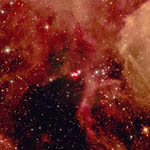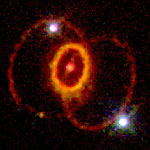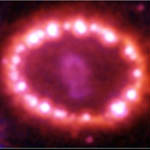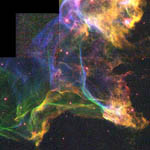| A supernova is an extremely violent star explosion that results in the total destruction of the star. The material that makes up the star is blown out into the surrounding regions.
There are two reasons why supernovas are important for understanding the conditions surrounding the formation of the Earth and Solar System:
- Evidence from unusual isotope abundances in meteorites suggest that a supernova triggered the collapse of the molecular cloud that ultimately formed the Earth and Solar System.
- The Big Bang created only hydrogen and some helium. All of the rest of the elements of the periodic table were produced in stars or during supernovas. Without supernovas, the elements heavier that helium would now largely be locked up in dead stars. Molecular clouds would consist only of hydrogen molecules and helium atoms. There would be none of the oxygen, carbon, iron, silicon, or any of the other elements that make up us and our world. When have you last thanked the humble supernova for your very existence?
|






